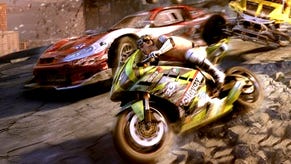Architect of the Apocalypse
MotorStorm Apocalypse designer Simon Barlow on balancing gameplay with blockbuster bombast.
We're mad. Completely mad. There are 40 unique races in this. Bear in mind the numbers of tracks we had in previous games [not counting DLC, that would be eight in MotorStorm, 16 in Pacific Rift – Ed] that's a hell of a lot. Even if you take out all of the events, and just had 40 unique races, that's still a hell of an undertaking.
So, yeah, we're crazy, but we set our stall out early. This is what we wanted. It had to be at this level, this big and this epic in scale. We just had to be very clever with the way we structured it. In one room we've got the production pipeline, the boring but important stuff. On one wall is the entire art flowchart and everybody's task is on a Post-It note, and we have a meeting every morning and you move your Post-It note along. You can see the flow of the art in the game.
In the other room is the flow of the game in terms of its story, aesthetic and chronology. We have a timeline of the city, what is happening to the city almost on an hourly basis, and we put races in there. So we'll go, OK, Dusklight, the private military contractor, they're going to bug out at this point. So we need to have a race around this time, as they're bugging out, because we need to see them leaving, firing back at the crazies and getting the hell out of there. It needs to be at night so when people are blowing s**t up it lights everything up and looks brilliant. So that's a night race. And you begin to fill in the gaps.

It's literally just based on what's cool. Wherever you've got your inspiration from, whether its inside your head or a film or a comic book or even a piece of music, something has clicked and we need to see this, it goes up on the wall. It just starts to form. Creativity forms when you give it some constraints. So our constraint is, it's got to be 48 hours, three guys, this is the city, these are the locations you can play around with. Other than that, it's free rein, basically.
It was a lot of work. A hell of a lot of work. And probably the best part of the three-and-a-half years we spent on this game was building these tracks, and making sure that the events and the choreography were right. We'd never done this before, so we had to get good at it.
It changes the balance, absolutely. You'd be amazed at how closely balanced it is. We've always had rules about how close vehicles have to be to each other. We've relaxed them a little for Apocalypse, and there's a reason for that. We used to have a three-second rule. Every vehicle had to be able to finish within three seconds of each other, or it wasn't balanced. We've slackened that out a little bit, but we've addressed it and added balance back in. Let me be clear about this. Balance is a state that the game is in. You don't really add balance, you add elements that help the balance. For the online experience, which is where it matters most, with 13 vehicle classes that will stretch a little bit.

If you pick a waterlogged track and you're going on a dirtbike or a chopper, you're screwed, pretty much. The way you compensate for that is by applying different perks to your vehicle. I really like the chopper, but it's not ideal for this sort of track, so I'm going to pick a loadout that allows me to reduce the water drag. I'm going to increase my boost cooling when I'm in water, and since I'll be in the water for most of the race, I'll be pretty much boosting all the time. That's another advantage for me. I'm also maybe going to take more of a beating. Everyone else is going to be in trucks, but I still like my chopper, so I'm going to increase the armour on it. I'm applying my own logic to it.
We're giving the player more freedom. Maybe initially, out of the box, people will look at it and think, oh, I'm never going to win on this. You can. You just have to trust us. We have got the game in a state of balance. We're happy with where we're at right now.


